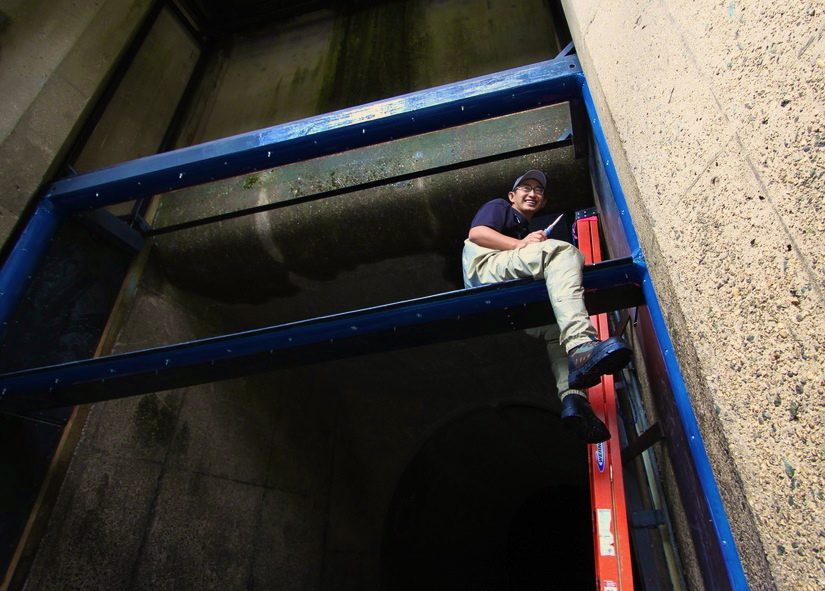Friday May 30, 2014
 Call it our most towering achievement: as a testament to their ingenuity and skill, our team has succeeded in constructing two of the largest PIT tag antennas in the world. Recently, members of FISHBIO had the opportunity to present this project at the 20th Symposium of the International Society on Biotelemetry in Kyoto, Japan. The symposium covered a wide range of topics, from telemetry applied to wildlife and human research, to satellite telemetry and underwater applications. Our presentation highlighted the success of the innovative PIT tag antenna arrays that we designed, fabricated, and deployed in two hydroelectric diversion tunnels in the Yuba River watershed. The two freestanding arrays measured 12 feet and 14 feet tall, respectively, and their performance was remarkable considering the conditions in which they were deployed. The PIT tag antenna arrays were used to monitor fish entrainment in two diversion tunnels that experienced flows as high as 12.1 feet per second, and discharges as high has 1,072 cubic feet per second. The arrays exceeded expectations by monitoring 99% of all flows diverted through the tunnels at an efficiency greater than 90%.
Call it our most towering achievement: as a testament to their ingenuity and skill, our team has succeeded in constructing two of the largest PIT tag antennas in the world. Recently, members of FISHBIO had the opportunity to present this project at the 20th Symposium of the International Society on Biotelemetry in Kyoto, Japan. The symposium covered a wide range of topics, from telemetry applied to wildlife and human research, to satellite telemetry and underwater applications. Our presentation highlighted the success of the innovative PIT tag antenna arrays that we designed, fabricated, and deployed in two hydroelectric diversion tunnels in the Yuba River watershed. The two freestanding arrays measured 12 feet and 14 feet tall, respectively, and their performance was remarkable considering the conditions in which they were deployed. The PIT tag antenna arrays were used to monitor fish entrainment in two diversion tunnels that experienced flows as high as 12.1 feet per second, and discharges as high has 1,072 cubic feet per second. The arrays exceeded expectations by monitoring 99% of all flows diverted through the tunnels at an efficiency greater than 90%.
The challenges associated with this project were numerous, but the experts at our very own FABLAB were able to draw upon their experience and ingenuity to design and fabricate PIT tag antennas of such a massive size. In fact, we are only aware of one other PIT antenna that is larger: one installed in Bonneville Dam on the Columbia River. At a size of 17 feet x 17 feet, this antenna misses nearly half of the tagged fish that pass through it. Our design allowed for coverage of nearly the same area, but with three separate antenna loops stacked one on top of the other, which resulted in a much higher detection efficiency across the entire diameter of the diversion tunnels. The arrays were hand molded from fiberglass into a hydrodynamic ‘wing’ shape to ensure that the large antenna would be resilient with minimal hydrodynamic drag. Each crossbeam was constructed with over 15 layers of 12-oz. fiberglass mat. Fiberglass did not interfere with the antenna’s detection field and provided sufficient strength, as the rigidity of the antenna was crucial to maintain proper tuning of the array. The PIT detection wire was embedded into the fiberglass as the antenna was fabricated. Our FABLAB also encased sensitive electronic equipment (the antenna tuners) in watertight housings that were submerged regularly, and occasionally at depths of up to twenty feet. It was rewarding to see our innovative design perform so well in a challenging setting.
We were glad to have the opportunity to share this unique project with the wider telemetry community, and have included our presentation below.
